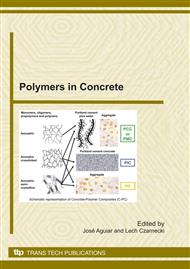[1]
D. Breton, A. Carles-Gibergues, G. Ballivy and J. Grandet: Contribution to the Formation Mechanism of the Transition Zone Between Rock and Cement Paste, Cement and Concrete Research Vol. 23(1993), pp.335-346.
DOI: 10.1016/0008-8846(93)90099-u
Google Scholar
[2]
T. Akçaolu, M. Tokyay and T. Çelik: Effect of Coarse Aggregate Size on Interfacial Cracking under Uniaxial Compression, Materials Letters Vol. 57, No. 4 (2002), pp.828-833.
DOI: 10.1016/s0167-577x(02)00881-9
Google Scholar
[3]
T. Akçaolu, M. Tokyay and T. Çelik: Effect of Coarse Aggregate Size And Matrix Quality on ITZ and Failure Behavior of Concrete Under Uniaxial Compression, Cement and Concrete Composites Vol. 26, No. 6 (2004), pp.633-638.
DOI: 10.1016/s0958-9465(03)00092-1
Google Scholar
[4]
W.A. Tasong, C.J. Lynsdale and J.C. Cripps: Aggregate-cement Paste Interface: Part I. Influence of Aggregate Geochemistry, Cement and Concrete Research Vol. 29 (1999), pp.1019-1025.
DOI: 10.1016/s0008-8846(99)00086-1
Google Scholar
[5]
D.P. Bentz: Influence of Silica Fume on Diffusivity in Cement-Based Materials. II. Multi-Scale Modeling of Concrete Diffusivity, Cement and Concrete Research Vol. 30, No. 7 (2000), pp.1121-1129.
DOI: 10.1016/s0008-8846(00)00263-5
Google Scholar
[6]
A.H. Asbridge, G.A. Chadbourn and C.L. Page: Effects of Metakaolin and the Interfacial Transition Zone on the Diffusion of Chloride Ions through Cement Mortars, Cement and Concrete Research Vol. 31, No. 11 (2001), pp.1567-1572.
DOI: 10.1016/s0008-8846(01)00598-1
Google Scholar
[7]
C. Poon, L. Lam, S.C. Kou, Y. Wong and R. Wong: Rate of Pozzolanic Reaction of Metakaolin in High-Performance Cement Pastes, Cement and Concrete Research Vol. 31 (2001), pp.1301-1306.
DOI: 10.1016/s0008-8846(01)00581-6
Google Scholar
[8]
K. Friedrich, S. Fakirov and Z. Zhang, in: Polymer Composites: From Nano-to-macro-scale, Springer Inc., New York(2005), pp.129-130.
Google Scholar
[9]
Z.H. Zheng and D. Feldman: Synthetic fiber-reinforced concrete, Progress in Polymer Science Vol. 20 (1995), pp.185-210.
Google Scholar
[10]
T.J. Chu, R.E. Robertson, H. Najm and A.E. Naaman: Effects of Poly(Vinyl Alcohol) on Fiber Cement Interfaces. Part II: Microstructures, Advanced Cement Based Materials Vol. 1, No. 3 (1994), pp.122-130.
DOI: 10.1016/1065-7355(94)90043-4
Google Scholar
[11]
ASTM E399, Standard Test Method for Linear-Elastic Plane-Strain Fracture Toughness K1c of Metallic Materials(1983).
DOI: 10.1520/e0399-20a
Google Scholar
[12]
ASTM E23, Standard Test Methods for Notched Bar Impact Testing of Metallic Materials(2009).
Google Scholar
[13]
T.L. Anderson, in: Fracture Mechanics, Taylor & Francis Group, Boca Raton, FL(2005), pp.288-289.
Google Scholar
[14]
Z. Sun, E.J. Garboczi and S.P. Shah: Modeling the Elastic Properties of Concrete Composites: Experiment, Differential Effective Medium Theory, and Numerical Simulation, Cement and Concrete Composites Vol. 29, No. 1 (2007), pp.22-38.
DOI: 10.1016/j.cemconcomp.2006.07.020
Google Scholar
[15]
H. Toutanji, B. Xu, J. Gilbert and T. Lavin: Properties of Poly(Vinyl Alcohol) Fiber Reinforced High-Performance Organic Aggregate Cementitious Material: Converting Brittle to Plastic, Construction and Building Materials Vol. 24, No. 1 (2010).
DOI: 10.1016/j.conbuildmat.2009.08.023
Google Scholar
[16]
D.P. Dias and C. Thaumaturgo: Fracture Toughness of Geopolymeric Concretes Reinforced with Basalt Fibers, Cement and Concrete Composites Vol. 27 (2005), pp.49-54.
DOI: 10.1016/j.cemconcomp.2004.02.044
Google Scholar
[17]
R. Griffiths and A. Ball: An Assessment of the Properties and Degradation Behaviour of Glass-Fiber-Reinforced Polyester Polymer Concrete, Composites Science and Technology Vol. 60 (2000), pp.2747-2753.
DOI: 10.1016/s0266-3538(00)00147-0
Google Scholar
[18]
M. Taylor, F.D. Lydon and B.I.G. Barr: Toughness Measurements on Steel Fibre-Reinforced High Strength Concrete, Cement and Concrete Composites Vol. 19 (1997), pp.329-340.
DOI: 10.1016/s0958-9465(97)00036-x
Google Scholar


